Legislative Analyst's Office
July 11, 1995
Los Angeles County’s Fiscal Problems
Background
- Proposed Budget. In June 1995, the Los Angeles County Chief Administrative Officer (CAO) submitted the county's 1995-96 proposed budget to the Board of Supervisors. It includes:
- Major reductions in health care for the indigent and closure of the nation's largest hospital--the LAC/USC Medical Center.
- Significant reductions to social service, public protection, recreation and other county programs.
- Elimination of 18,250 budgeted positions (a reduction of 20 percent).
- Reason for Budget Reductions. The Los Angeles CAO indicates that the reductions are needed to close a $1.3 billion shortfall in the county budget, created by past shifts in property taxes to schools, reductions in federal support for health care, and other factors.
- Scope of LAO Review. The purpose of this document is to provide an overview and assessment of the county's current fiscal condition and budget problem, including:
- The magnitude of the county's budget problem.
- The major causes and components of the budget problem.
- Options for addressing the problem.
What Is the Magnitude of the County's Budget Problem?
- $1.3 Billion Shortfall Identified by the County CAO. The CAO estimated in June 1995 that the county faces a $1.3 billion budget shortfall in 1995-96. Total county spending in the just-concluded fiscal year was about $12.4 billion. Thus the CAO's estimated shortfall represents about 10 percent of the county's overall 1994-95 budget.
- However, roughly $10 billion of the county's spending is financed by a combination of federal and state funding or fee revenues that are tied to specific programs or services.
- Consequently, the shortfall identified by the CAO represents about half of the size of the county's general purpose revenues and represents a massive budget problem.
- The discussion that follows focuses on the shortfall in the county's general purpose budget.
- LAO Assessment of Budget Shortfall. Based on a review of the budget-related information made available to us, the county's estimate of its underlying budget problem appears generally correct.
- If we use a methodology for calculating the county's budget shortfall that is similar to how we calculate the state's budget gaps, we would end up with a smaller gap than the county projects.
- However, our methodology also would by definition reduce the value of the solutions the county is proposing by an equivalent amount.
- The net effect is that our estimate of the need for actual budget reductions or additional revenues is similar to the county's.
- Our methodologies differ because:
- The CAO's shortfall estimate includes a net county cost of $167 million for the impact of the Governor's state/county realignment proposal, but also includes as a budget solution a deferral of action on this proposal. Our methodology would exclude this factor both as a cost and solution, because the current conference version of the state budget does not adopt the realignment proposal.
- We also would include existing reserves as an available budget resource, whereas the CAO treats the drawdown of reserves as a budget solution.
What Factors Contribute to the County's Budget Problem?
- Property Tax Shifts. The state's 1992-93 and 1993-94 Budget Acts shifted about $1 billion of property taxes from the county to public schools.
- About 40 percent of these reductions in property taxes are mitigated by sales
taxes dedicated to public safety purposes, as shown in Figure 2.
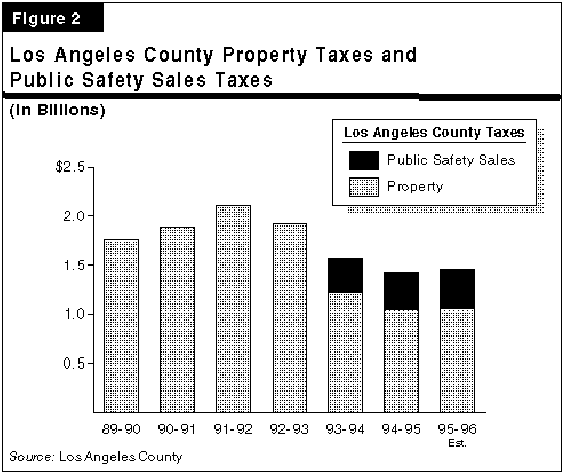
- These sales tax revenues are the result of Proposition 172, that established a permanent statewide half-cent sales tax for support of local public safety functions in cities and counties.
- About 40 percent of these reductions in property taxes are mitigated by sales
taxes dedicated to public safety purposes, as shown in Figure 2.
- County Health Program Utilization and Financing. The county administers the nation's second largest public health care system, including 6 major hospitals, 6 comprehensive health centers, and 39 community health centers.
- The county health system serves a large number of indigent patients and others who are uninsured.
- Its system is significantly affected by changes in federal and state health care spending as well as the demand for health care services by low income residents.
- More generally, the county system is operating in an increasingly competitive environment and is facing many of the pressures that apply to the health care industry at-large.
- Major Loss of Federal Funds. As shown in Figure 3, total federal Medi-Cal related payments to the county Department of Health Services (DHS) are estimated to fall from $1.3 billion in 1994-95 to $982 million in 1995-96.
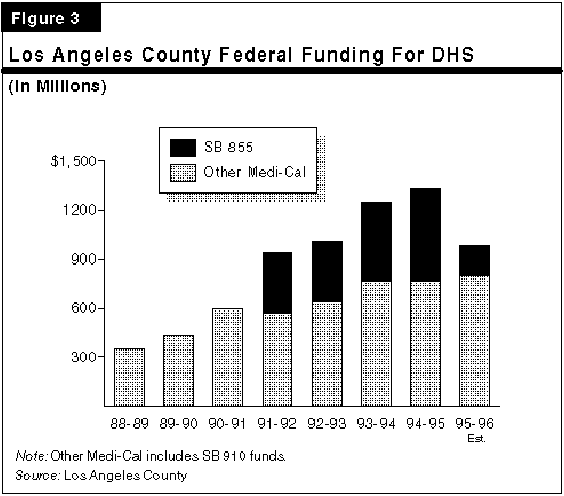
- Much of the decline is related to reductions in the SB 855 program, that was created in 1991 to provide supplemental federal reimbursements to hospitals which serve a disproportionate share of low-income persons. Total funding for the SB 855 program will fall from $564 million in 1994-95 to $179 million in 1995-96, due to three factors:
- The Settlement of One-Time Claims. The county covered part of its budget shortfalls in 1992-93 through 1994-95 through the settlement of prior year claims. In addition, it accelerated SB 855 payments from 1995-96 into 1994-95 to cover an unanticipated shortfall in SB 910 payments. These one-time sources are exhausted in 1995-96.
- Caps on the Program. Federal law changes enacted in 1993 capped the amount of supplemental payments to hospitals, limiting growth in this program.
- Declining Share Of Supplemental Funds. The county also is receiving a declining share of federal benefits under the SB 855 program, due to increasing competition from private hospitals that serve low-income patients.
- Much of the decline is related to reductions in the SB 855 program, that was created in 1991 to provide supplemental federal reimbursements to hospitals which serve a disproportionate share of low-income persons. Total funding for the SB 855 program will fall from $564 million in 1994-95 to $179 million in 1995-96, due to three factors:
- State Offset. The loss in federal funding has been compounded by the state offset of federal SB 855 funds that would otherwise go to counties. In 1995-96, the county estimates that its loss due to the state offset will be $120 million.
- Slow Growth in Local Taxes. Property taxes, sales taxes, and vehicle license fees have been impacted by the recession. For example, the single largest general purpose revenue source, property taxes, increased by almost 10 percent per year in the 1980s, but is projected by the county to decline by 1.6 percent in 1995-96.
- Employee Pay Increases. In many county departments, employee salaries have increased faster than inflation since 1988-89. These salary increases have contributed to cost pressures within the county's budget. Specifically, our review of general salary increases granted to 58 job categories over the last seven years indicates that:
- Nearly half of the county's job categories received a general salary increase ranging from 20.4 percent to 34 percent, that exceeded the growth in the Los Angeles area CPI (about 20 percent).
- Nearly a third of the job categories received general salary increases exceeding 25 percent.
- One-Time Measures. The county has relied on one-time measures to cover recent budget shortfalls. Some of these actions aggravate the budget problem in 1995-96.
- It issued bonds to cover operating expenses in 1992-93 (Marina Del Rey) and in 1994-95 (to cover its pension fund liabilities). These actions raise the ongoing debt service costs to the county.
- It used prior-year settlement payments and acceleration of future federal payments under the SB 855 program to balance its health budget in the 1992-93 through 1994-95 fiscal years.
- It also depleted reserves, deferred obligations to its workers' compensation fund, and deferred certain employee costs to balance recent budgets.
Figure 1 indicates that there are seven principal factors which are responsible
for the budget problem: 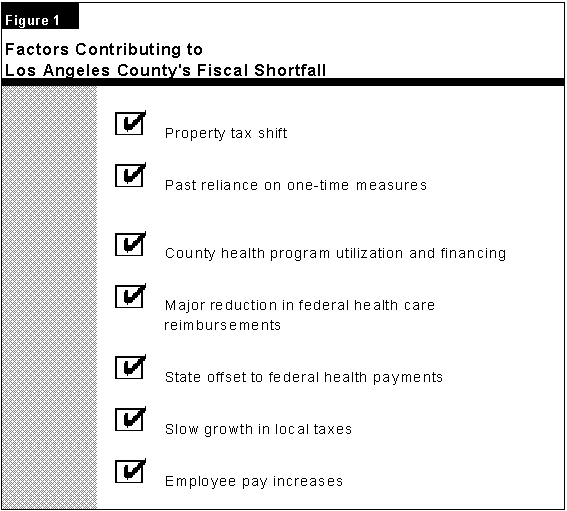
What Are the County's Plans for
Dealing with its Fiscal Problem?
- Overview. The proposed budget relies almost exclusively upon program reductions as a means of addressing the county's fiscal problem.
- Non-Health Reductions. In general, the county's budget reduces all departments by 20 percent of the amount funded by county revenues, unless a statutory maintenance of effort (MOE) provision requires a higher level of county funding. As Figure 4 indicates, this reduction will lower county expenditures by $207 million. In addition, the budget requires county departments to absorb $103 million in baseline cost increases.
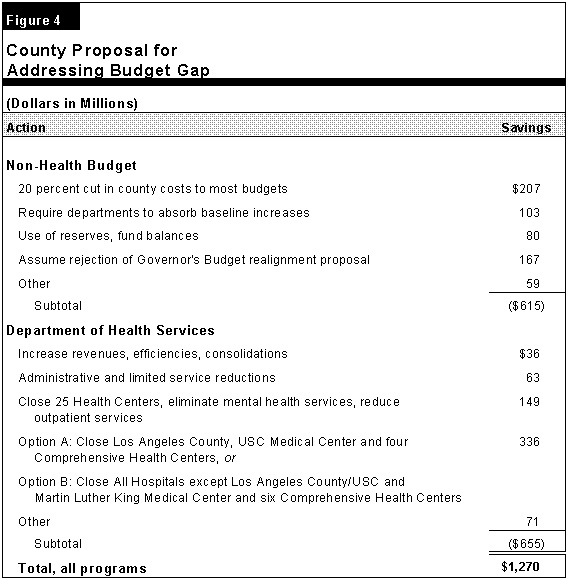
- Public Protection. Proposed total spending on public protection activities declines by 2.1 percent in 1995-96 compared with 1994-95 spending. The reduction is relatively modest in part due to the need to meet state MOE funding requirements for continued Local Public Safety Fund allocations. However, the amount of reduction varies considerably among departments, and all departments would have to make cuts to absorb baseline cost increases.
- Sheriff. The proposed budget for the Sheriff's Department is essentially flat. Total spending would be $1.1 billion, including Local Public Safety Fund allocations with $567 million financed from general county revenues. However, budgeted positions decline by 452 (3.5 percent) in order to absorb baseline cost increases. The CAO indicates that any further reductions would reduce the Sheriff's budget below the state MOE requirement (the Sheriff believes that the budget slightly underfunds the MOE requirement).
- District Attorney. General county revenues provided to the District Attorney would decline by $7.4 million (11 percent) compared with 1994-95, and budgeted positions decline by 202 (12 percent).
- Probation. Proposed total spending of $259 million declines by $52.3 million from 1994-95, and budgeted positions decline by 1,034 (24 percent).
- Courts. The budget provides $427 million for the superior and municipal courts. Budgeted positions would decline by 350 (7.7 percent).
- Major Reductions in Health Care System. To cover an estimated $655 million shortfall in its DHS budget, the county proposes to substantially reduce the size of its health care system. The plan includes two options, both of which would involve the closure of at least one major hospital, and several comprehensive health centers. The proposal is summarized in Figure 4.
- Implementation costs create $300 million budget pressure. The CAO's budget proposal identifies $332 million (Option A) or $293 million (Option B) of additional one-time implementation costs that will partially offset the budgeted DHS savings of $655 million in 1995-96. These implementation costs reflect the loss of savings due to delayed action past July 1, amounts owed to laid-off employees, and the payoff of debt incurred to plan new facilities not included in the budget. These unfunded costs create a hole in the CAO's budget proposal of roughly $300 million, which the CAO proposes to fill by reserving additional federal funds that may result from the approval of pending county claims.
- Health Care Reductions Would Have Major Impact. The reductions proposed by the CAO would clearly have a major impact on health care services in the county. The shutdown of major facilities would result in a combined loss in federal, state, and county funds for health care of $1.2 billion.
- Public Protection. The CAO's budget would reduce public protection services and resources in a number of areas.
- Sheriff. The Sheriff's Department closed two jail facilities in March. Other savings would be achieved primarily by reducing or deferring purchases of equipment and supplies. The Sheriff indicates that he also may implement alternative or additional reductions if the board approves the CAO's proposed level of funding.
- District Attorney. Reductions in the District Attorney's office would be concentrated in administrative and support functions, but there also would be a reduction of 154 prosecutor positions.
- Probation. Proposed budget reductions include the closure of five juvenile camps or one juvenile hall, as well as the closure of six area offices.
- Courts. Reductions would eliminate 43 commissioners and 6 assigned judges. Electronic court reporting would be expanded and administrative and support functions would be reduced.
- Number of Positions Eliminated. The proposed county budget eliminates
18,250 positions, or over 20 percent of the county's budgeted positions.
The number of county employees actually laid-off, however, would be lower
than 18,250 because some budgeted positions are not filled and some employees
normally choose to leave county employment in any year. The CAO estimates
the actual number of employees to be laid-off will be about 10,000 to 12,000.
The majority of these layoffs will involve health care workers. Figure 5
displays information on the number of county employees.
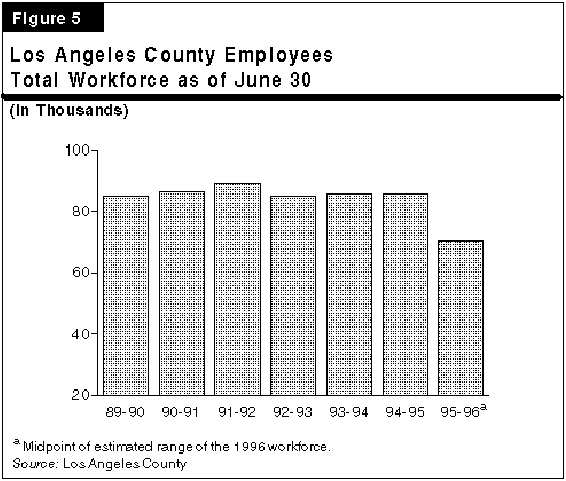
- Status of Layoffs. The county has already issued layoff notices to about 50 employees and will issue another 2,000 layoff notices by mid-July. The Board of Supervisors directed several large departments, including the DHS and the Sheriff, to postpone issuing layoff notices in order to give the board additional time to evaluate alternatives.
- Layoff Procedures. The county indicates that it expects the process of laying off non-health care employees to take about three to six weeks. Because the closure of medical centers requires the concurrence of state and federal regulatory agencies, the layoffs of health care workers likely would be phased over a longer time period. The county indicates that layoffs would be determined by seniority within a department and within a position classification.
- Unbudgeted Costs. The budget does not include costs to pay terminated employees for their accrued vacation time, sick leave, and any deferred salary increases or accumulated time off. These county costs to terminate employees could be in the range of millions to tens of millions of dollars.
Other Options For Addressing County Fiscal Problem
- The Board of Supervisors is currently considering a variety of alternative options for dealing with the budget shortfall. For example, the board has created a Health Crisis Task Force to identify alternatives to the proposed cuts in the health care budget. It is our understanding that the task force will report its findings to the board by the end of the month.
- In addition, other proposals have been suggested by union representatives, public officials, and other public and private representatives for mitigating the proposed major budget cuts.
- Some of these and related options are summarized in Figure 6.
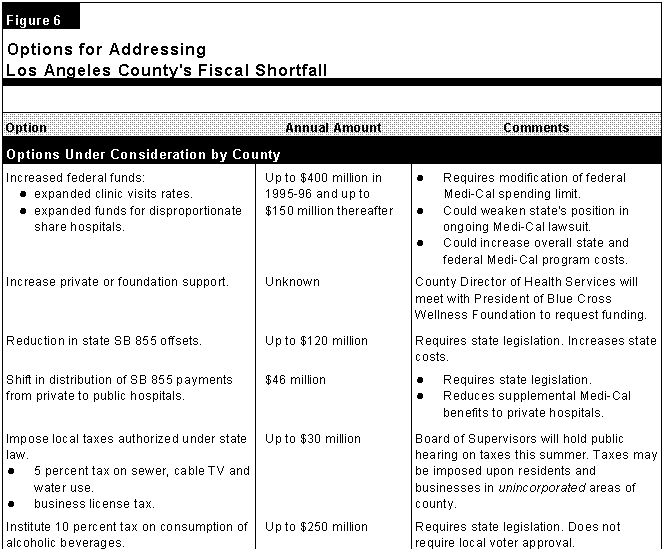
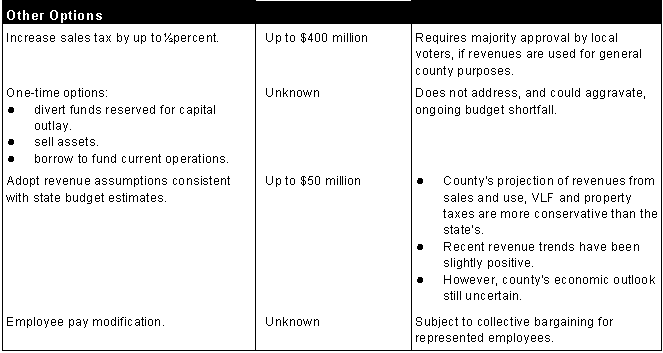
- Federal Reimbursement Options. The county is pursuing several proposals to increase federal health care revenues. For example, the county is currently negotiating with state and federal officials over the replacement of SB 910 reimbursement claims that were rejected last year. (The SB 910 program was created to enable counties to claim Medi-Cal reimbursements for administrative and case management expenses associated with health care. The majority of SB 910 claims were rejected by the federal government last year.)
- A possible vehicle for SB 910 replacement is an increase in reimbursements for expanded health clinic visits. Retroactive provision for expanded care would increase reimbursements by up to $340 million in 1995-96, and $80 million thereafter. The state has been resistant to expanded payments because of their possible effects on existing litigation regarding Medi-Cal reimbursement rates.
- The county is also submitting a proposal for expanding the SB 855 hospital caps, that would enable county hospitals to increase reimbursements under the program. However, the federal government has thus far resisted proposals for expansion of the caps, in part because of the possible impact on the federal budget deficit.
- Currently-Authorized Tax Options. These include:
- Sales Taxes. Upon approval by a majority of the county's voters, the county could increase the local sales tax by 1/4 or 1/2 of one percent and use the funds for general county purposes. (Taxes for specific purposes require a two- thirds vote of the electorate.) The sales tax rate in Los Angeles County is currently 8.25 percent. Increasing the sales tax rate by 1/2 of one percent would raise about $400 million annually.
- Other Taxes. The county has scheduled a public hearing to consider imposing taxes on businesses in the unincorporated area--and instituting taxes on water, sewer and cable television use by people living in the unincorporated area. (Current law prohibits counties from imposing these taxes upon city businesses and residents.) Due to the limited nature of these taxes, the county estimates that they are unlikely to generate more than $30 million annually.
- New Local Revenue Option--Tipplers' Tax. The county developed a legislative proposal to grant it authority to impose a "tipplers' tax" on the consumption of alcohol in the county. Imposing such a tax would require a super- majority vote of the County Board of Supervisors. The county estimates that this tax could generate $200 million to $250 million annually.
- Modify County Employee Salaries. The county could consider rescinding scheduled 1995-96 pay increases and/or reducing current pay levels.
- We have been unable to verify the status of collective bargaining agreements (for example, when they expire, when negotiations are planned for new agreements, or whether the existing agreements can be reopened in a fiscal emergency).
- During the course of our review, however, we found no evidence that the county has considered these options.
- For non-represented employees, these options could be implemented regardless of the status/content of bargaining agreements.
Conclusion
- The current budget shortfall is reflective of a major structural imbalance between program costs and revenues, primarily caused by the combination of property tax shifts, sluggish revenue growth, and declining federal funds.
- Based on the current economic outlook for the state and county, it is extremely unlikely that revenue growth from existing sources will be sufficient to cover the gap in the foreseeable future.
- While the county could adopt one-time measures to cover part of the shortfall in 1995-96, longer-term solutions to its budget problem will need to include permanent revenue increases or program reductions. Furthermore, about $300 million of one- time funds would be needed to cover the implementation costs of the DHS reductions.
- More fundamentally, the county's hospital and health care delivery system is likely to face continuing fiscal pressures from intense competition for insured patients and continuing demand to provide uncompensated care.